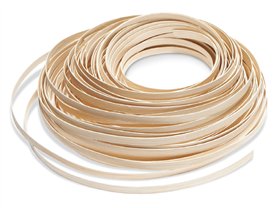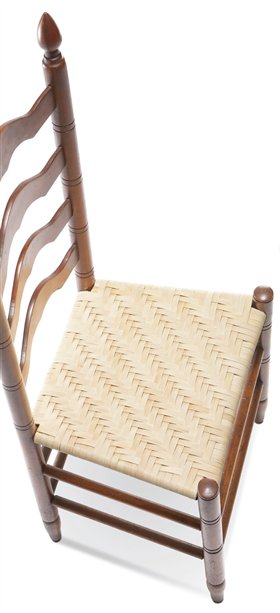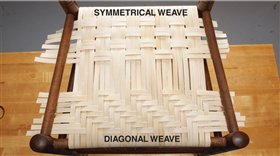We may receive a commission when you use our affiliate links. However, this does not impact our recommendations.

Weave Traditional Chair Seats
Traditional techniques and modern materials produce attractive, durable results.
by Tim Johnson
Visit any antique or second-hand furniture store and you’ll find great old chairs—such as these solid cherry ladderbacks—that are bargain priced because their woven seats have worn out. In fact, any chair with round rails or dowels used to form the seat frame can have a splint or a rush seat installed.
The choice is mainly an aesthetic one. Splint seats (above left) are created by weaving together flat lengths of wood that have been soaked in water to make them pliable. Rush seats (above right) are installed by wrapping twisted strands of fiber around each corner of a chair in a continuous loop. Both seats take about the same amount of time to install and the cost for materials is similar. With proper use and occasional maintenance, both seats can provide ten or more years of service.
I find installing these seats satisfying, quiet work. Yes, it takes time, but the techniques aren’t difficult and mastering them connects you to an ancient craft.
How to weave a splint seat
Traditionally, splints were split by hand from native hardwoods such
as ash, oak and hickory. Flat reed splint made from the stem of the
tropical rattan palm is much more common today. The rattan palm is a
climbing vine-like tree; its stems can grow up to 600 ft. long!
A uniform creamy-white color, flat reed splint comes in different
widths and is machined to uniform thickness. Flat oval reed splint is
also available. It has a rounded top surface. The amount you’ll need
depends on the size of your chair seat and the width you choose. I used
just over one bundle of 1/2 in. splint for this chair, which has an
average-size seat. Bundles cost $15 or less (see Source, page 40).
Flat reed splints should be soaked in hot water for at least twenty
minutes prior to use. Each splint has a top and bottom face—always
weave with the top face up. The top face is smoother to the touch. You
can also bend the splint into a tight “U”; small fibers breaking away
on the outside of the curve indicate the bottom face. Thinned varnish
(equal parts mineral spirits and varnish) applied to both the top and
bottom sides helps to protect splint seats from drying out due to
seasonal changes in humidity. Splint seats can also be stained; seal
with varnish to keep the stain from rubbing off onto clothing. |
|
Click any image to view a larger version.

Splint seats are created by weaving together flat lengths of wood that have been soaked in water to make them pliable. |
| A uniform creamy-white color, flat reed splint comes in different widths and is machined to uniform thickness. Flat oval reed splint is also available. It has a rounded top surface. |
|
 |
| 1. Chair seats are usually wider at the front, so the first step is to establish a rectangular seat area. Mark the front rail while holding a square against the back rail, with its corner against the back leg. |
|
 |
| 2. Nail the first splint to the back rail. Draw it over the rail and forward around the front rail at your reference mark. Take out the slack, wrap the splint back around the back rail and draw it forward again. Continue this process to wrap the entire length of splint. |
|
 |
| 3. Connect new lengths of splint on the bottom. Use a spring clamp to keep the wrapped splint under tension. Overlap the previous length by about 6 in. and staple all along the overlap. Orient the staples crown-side-out. |
|
 |
| 4. Keep wrapping splint front-to back until you reach the opposite reference reference mark on the front rail. Cut the splint and staple it to the adjacent underside loop. This layer, now completed, is called the warp. |
|
 |
| 5. Weaving is the next step. Experiment with different patterns, using short splints. Simply alter the over-under counts between the weave and warp splints. We’ll proceed with the diagonal “herringbone” pattern. |
|
 |
| 6. Establish the back edge. Weave a length of splint, called a “weaver,” across the warp, using a 3-under, 3-over pattern that’s centered, so the weaver passes under the same number of warp splints at both ends. Cut the ends flush. |
|
 |
| 7. To create the diagonal pattern, shift the 3-under, 3-over pattern by one warp splint with each new row: Here, the back weaver started “2-under,” so this weaver starts “3-under.” On the next row, the weaver will start “1-over.” |
|
 |
| 8. Wrap the weaver around the rail and weave it across the seat’s bottom, using the same pattern as on the top. Secure the next weaver by overlapping the end of the first weaver by 6 to 8 inches and weaving it in. |
|
 |
| 9. When the seat is about half finished, fill in the corners by weaving in additional warp splints. Lock them in place on the top by looping their ends around weaver splints and drawing out the slack. On the bottom, just weave them in. |
|
 |
| 10. Completing the last few rows is challenging, because the seat becomes more taut as you weave. A table knife spreads the warp and helps to guide the splint. |
|
 |
How to weave a rush seat
Natural rush strands are made from cattail leaves. Fiber rush, made
from kraft paper (think grocery store bags), is an economical
substitute that’s more widely available than natural rush and much
easier to use.
Fiber rush comes in a variety of colors and diameter sizes. The
smaller the diameter, the longer it takes to complete a seat; larger
diameters are stiffer and harder to work with. Fiber rush is commonly
available in 2 lb. coils and costs $10 to $15 per coil (see Source,
below). I always buy two coils for every chair seat, to make sure I
have enough. I also check the color, to make sure the coils match.
Make fiber rush more pliable before use by misting it with water
from a pump spray bottle. Two keys to success are to keep the strands
consistently twisted and consistently taut as you weave. Use short
strands at first, to build out the front corners, then work with
strands that are 20 to 25 ft. long. Use a spring clamp to maintain the
tension when you tie in new stands. Finish fiber rush seats with two
coats of shellac thinned to a 1 lb. cut. |
|

Rush seats are installed by wrapping twisted
strands of fiber around each corner of a chair in a continuous loop. |
| Natural rush strands are made from cattail leaves. Fiber rush, made from kraft paper (think grocery store bags), is an economical substitute that’s more widely available than natural rush and much easier to use. |
|
 |
| 1. Chair seats are usually wider at the front, so the first step is to establish a rectangular seat area. Mark the front rail while holding a square against the back rail, with its corner against the back leg. |
|
 |
| 2. Rush seats are woven by repeating one wrapping pattern. Starting from the left rail, draw the rush strand over and around the front rail. Continue up, over and around the left rail, turning 90 degrees and crossing over the strand. Draw the strand to the top of the right rail and repeat the pattern. It’s that simple. |
|
 |
| 3. Create the rectangular seat area by filling the front corners, using short, individual strands wrapped around both front legs and tacked to the side rails. Each successive strand builds the seat toward the center. |
|
 |
| 4. Once the rectangular seat area is established, wrapping begins in earnest. Tack a long strand to the left rail and begin a continuous counter-clockwise loop that wraps around all four corners.
|
|
 |
| 5. Tie in new strands on the underside of the seat, using a square knot. Always keep the strands taut. |
|
 |
| 6. As you wrap each corner, it’s important to keep the rush strands at right angles and to straighten the diagonal line formed by the crossover joints. Pinching each crossover joint makes the job easier by compressing the strands. |
|
 |
| 7. Press the rush strands to the corners to fill gaps and keep uniform spacing. Fiber rush comes in different sizes. Larger sizes build the seat faster, but they’re harder to pinch and press, so a few gaps are likely to remain. |
|
 |
| 8. When the seat is about two-thirds complete, fill the space between the top and bottom strands to add support. Install two or three layers of cardboard that’s been cut to fit inside the seat’s four triangular-shaped sections. |
|
 |
| 9. When the seat area is wider than it is deep, the final wrapping goes front to back, through the ever-shrinking hole in the middle of the seat. If the seat is deeper than wide, the wrapping goes side to side. |
|
 |
Product Recommendations
Here are some supplies and tools we find essential in our everyday work around the shop. We may receive a commission from sales referred by our links; however, we have carefully selected these products for their usefulness and quality.































